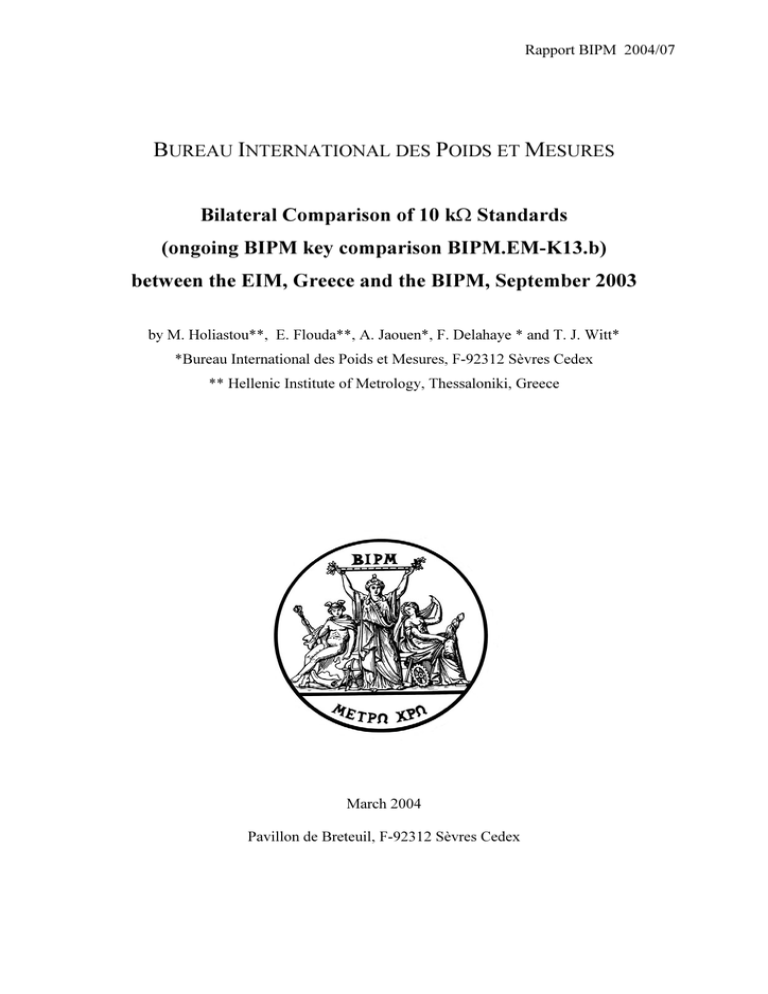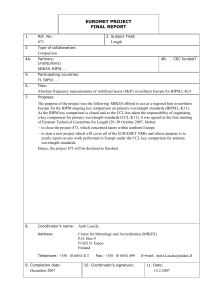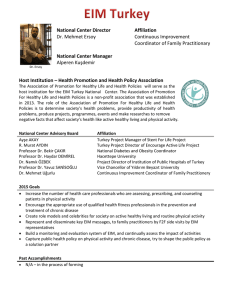Bilateral Comparison of 10 kΩ Standards (ongoing BIPM key
advertisement

Rapport BIPM 2004/07 BUREAU INTERNATIONAL DES POIDS ET MESURES Bilateral Comparison of 10 kΩ Standards (ongoing BIPM key comparison BIPM.EM-K13.b) between the EIM, Greece and the BIPM, September 2003 by M. Holiastou**, E. Flouda**, A. Jaouen*, F. Delahaye * and T. J. Witt* *Bureau International des Poids et Mesures, F-92312 Sèvres Cedex ** Hellenic Institute of Metrology, Thessaloniki, Greece March 2004 Pavillon de Breteuil, F-92312 Sèvres Cedex Rapport BIPM 2004/07 Bilateral Comparison of 10 kΩ Standards (part of the ongoing BIPM key comparison BIPM.EM-K13.b) between the EIM, Greece and the BIPM, September 2003 by M. Holiastou**, E. Flouda**, A. Jaouen*, F. Delahaye * and T. J. Witt* *Bureau International des Poids et Mesures, F-92312 Sèvres Cedex ** Hellenic Institute of Metrology, Thessaloniki, Greece A comparison of the 10 kΩ reference standards of the BIPM and the Hellenic Institute of Metrology (EIM), Thessaloniki, Greece, was carried out from July 2003 to January 2004. Three BIPM 10 kΩ travelling standards, B10K07, B10K08 and B10K09 were shipped to the EIM by air courier. The BIPM measurements of the travelling standards were carried out at a mean temperature of 23.1 °C by comparison with two BIPM 10 kΩ reference standards using a Warshawsky bridge. The two reference standards are linked to a BIPM 100 Ω transfer resistor whose value is known with respect to the BIPM Quantized Hall Resistance (QHR) standard. The measuring current in the 10 kΩ resistors was 0.1 mA. The EIM measurements were carried out at a mean temperature of 23.3 °C by direct comparison with a quantum Hall effect device, using a bridge based on a cryogenic current comparator. The measuring current used was 0.05 mA. Further information about the EIM measurement system and procedure are given in Appendix 1. The reference temperature to which all measurements were referred is 23 °C. The pressure coefficients of the three travelling standards are negligible. The power coefficients are also negligible and no significant uncertainty results from the use of different measuring currents by the two laboratories. Figures 1, 2 and 3 show the measured values obtained for the three standards by the two laboratories. A linear least-squares fit to the BIPM values is used to calculate the BIPM values for the reference date 30 September 2003 which is approximately the mean date of the EIM measurements for each of the three standards . Each EIM result (six results for B10K07 and B10K09, five results for B10K08) is the unweighted mean of the results of EIM measurements carried out on a given day (from 7 to 17 individual measurements per day and per standard). The uncertainty bars correspond to the Type A standard uncertainties of the unweighted means. The EIM value at the reference date is the weighted mean of the five or six EIM results; each weight is proportional to the square of the reciprocal of the Type A standard uncertainty. 1/8 Rapport BIPM 2004/07 Table 1 lists the results and the component uncertainty contributions for the comparison EIM/BIPM. Table 2 lists the uncertainties associated with maintenance and measuring equipment at the BIPM and Table 3 lists the uncertainties associated with maintenance and measuring equipment at the EIM. The following elements are listed in Table 1: (1) The mean resistance value REIM of each resistor measured by the EIM; (2) The Type A uncertainty due to the instability of the resistors and the measuring equipment of the EIM, computed as the standard uncertainty of the weighted mean for each resistor; (3) The Type B uncertainty component due the measuring equipment of the EIM; (4-6) The corresponding quantities for the BIPM; (7) The difference (REIM − RBIPM) for each resistor; (8) The clearly uncorrelated (Type A) part of the uncertainty; (9) The result of the comparison which is the unweighted mean of the differences of the calibration results for the different standards; (10) The expected Type A transfer uncertainty, x', based on the Type A uncertainties of the individual results; (11) The a posteriori transfer uncertainty, x, which is the standard deviation of the mean of the three different results. As x is larger than x', the former is retained as an estimation of the Type A transfer uncertainty; (12) The total uncertainty of the comparison, which is the root-sum-square (RSS) of the Type A transfer uncertainty and the Type B components. The final results of the comparison are presented as the difference between the value assigned to a 10 kΩ standard by each laboratory. The difference between the value assigned by the EIM, at the EIM, REIM, and that assigned by the BIPM, at the BIPM, RBIPM, for the reference date is REIM − RBIPM = 0.73 mΩ ; uc = 0.35 mΩ on 2003/09/30, where uc is the total standard uncertainty of the comparison. For both participants, the combined uncertainties are largely dominated by Type B uncertainties for which the numbers of degrees of freedom are infinite. Thus, to a good approximation, the value of the coverage factor, k, corresponding to a 95 % confidence level is 2. 2/8 Rapport BIPM 2004/07 This is a satisfactory result. The difference between the values assigned to the travelling standards by the two laboratories is of the order of the expanded uncertainty (k = 2). _____________________________________ B10K07 (K201119630104) 1.6000 EIM 1.5600 EIM 30/09/2003 (weighted mean) 1.5400 BIPM BIPM on 30/09/2003 (from linear fit) 1.5200 1.5000 1.4800 y = 0.00007664834x - 1.42831922324 1.4600 Date Figure 1. Relative deviation from the nominal 10 kΩ value of the resistance of B10K7 vs time: a linear least-squares fit to the BIPM measurements (full line) and the weighted mean of the EIM measurements. Uncertainty bars correspond to standard uncertainties of Type A only. For each individual BIPM result, the Type A standard uncertainty is about 3 parts in 109. 3/8 03/02/04 14/01/04 25/12/03 05/12/03 15/11/03 26/10/03 06/10/03 16/09/03 27/08/03 07/08/03 18/07/03 1.4400 28/06/03 106x[(R -104 Ω)/104 Ω] 1.5800 Rapport BIPM 2004/07 B10K08 (K201039730104D) 0.3700 EIM EIM 29/09/2003 (weighted mean) 0.3300 BIPM BIPM on 29/09/2003 (from linear fit) 0.3100 0.2900 6 4 4 10 x[(R -10 Ω)/10 Ω] 0.3500 0.2700 y = 0.00005151466x - 1.68300220020 Date Figure 2. Relative deviation from the nominal 10 kΩ value of the resistance of B10K08 vs time: a linear least-squares fit to the BIPM measurements (full line) and the weighted mean of the EIM measurements. Uncertainty bars correspond to standard uncertainties of Type A only. For each individual BIPM result, the Type A standard uncertainty is about 3 parts in 109. 4/8 03/02/04 14/01/04 25/12/03 05/12/03 15/11/03 26/10/03 06/10/03 16/09/03 27/08/03 07/08/03 18/07/03 28/06/03 0.2500 Rapport BIPM 2004/07 B10K09 (K203039730104D) -0.4300 EIM EIM 01/10/2003 (weighted mean) BIPM BIPM on 01/10/2003 (from linear fit) -0.4700 -0.4900 -0.5100 y = 0.00018162841x - 7.40608940471 -0.5300 Date Figure 3. Relative deviation from the nominal 10 kΩ value of the resistance of B10K09 vs time: a linear least-squares fit to the BIPM measurements (full line) and the weighted mean of the EIM measurements. Uncertainty bars correspond to standard uncertainties of Type A only. For each individual BIPM result, the Type A standard uncertainty is about 3 parts in 109. 5/8 03/02/04 14/01/04 25/12/03 05/12/03 15/11/03 26/10/03 06/10/03 16/09/03 27/08/03 07/08/03 18/07/03 -0.5500 28/06/03 106x[(R -104 Ω)/104 Ω] -0.4500 Rapport BIPM 2004/07 Table 1. Results of the EIM/BIPM bilateral comparison of 10 kΩ standards using three BIPM travelling standards: reference date 30 September 2003. Uncertainties are 1σ estimates. The combined Type A uncertainty is w=[r2+ t2]1/2, the expected transfer uncertainty is x' = [wB10K072+ wB10K082+ wB10K092]1/2/3, the a posteriori transfer uncertainty is x, the standard deviation of the mean < REIM − RBIPM >, and the total combined uncertainty is y=[s2+u2+x2]1/2. 1 2 EIM 3 4 5 (R − 10 000 Ω)/mΩ Type A uncertainty/mΩ B10K07 15.63 0.03 B10K08 3.42 0.04 −4.65 0.04 (R − 10 000 Ω)/mΩ Type A uncertainty/ mΩ 14.76 0.02 6 Type B uncertainty/ mΩ 7 8 (REIM − RBIPM)/ mΩ Combined Type A uncertainty/ mΩ 9 10 11 12 < REIM − RBIPM >/ mΩ 2.69 0.02 −5.23 0.02 Expected type A transfer uncertainty/ mΩ sM of difference for 3 resistors/ mΩ Total uncertainty in comparison / mΩ t u 0.15 0.87 0.04 r s 0.30 Type B uncertainty/mΩ BIPM B10K09 0.73 0.05 0.58 0.05 0.73 0.03 0.08 0.35 w x' x y Table 2. Estimated Type B standard uncertainties, relative to the nominal value, for 10 kΩ calibrations with the BIPM equipment. Measurement of the two BIPM 10 kΩ reference standards in terms of RH(2) Extrapolation of the mean value of the two reference standards Measurement of the bridge unbalanced voltage Measurement of the voltage applied to the bridge Leakage resistances Temperature correction RSS Total 10 × 10−9 7 × 10−9 5 × 10−9 5 × 10−9 2 × 10−9 3 × 10−9 15 × 10−9 Table 3. Estimated Type B standard uncertainties, relative to the nominal value, for 10 kΩ calibrations with the EIM equipment. Realization of the QHR at EIM Measurement of the 10 kΩ standards in terms of the QHR using the CCC bridge, including possible effect of noise rectification Temperature correction RSS Total 6/8 2 × 10−9 30 × 10−9 3 × 10−9 30 × 10−9 Rapport BIPM 2004/07 Appendix 1: EIM measurement system and procedure The measurement system is basically comprised of the cryogenic components that enable the cooling of the quantum Hall device (i.e. cryostat, 3He insert and superconducting magnet), a cryogenic current comparator (CCC) bridge in its cryostat, the measurement electronics, and a PC; all supplied by “Cryogenic” (UK). The quantum Hall device is a GaAs/GaAlAs heterostructure obtained from BIPM and manufactured in the Laboratoires d’Électronique Philips (LEP). The 10 kΩ resistors under test were placed in the calibration room, where the temperature was controlled to 23 oC and were allowed to stabilize for 9 days prior to the measurements. Then, they were directly compared to the quantum Hall device quantized to the i = 2 plateau. The i = 2 plateau was obtained at a magnetic flux density of 9.9 T and a temperature of 0.3 K, and its value is accepted to be 12906.4035 Ω. The temperature of the 10 kΩ resistors during the measurements was measured either with a standard Pt resistance thermometer or, in some cases, with a Type K thermocouple, either one placed in the special well of the resistor, and did not deviate more than 0.01 oC. Several sets of measurements were obtained for each resistor, covering a period of 14 days in total. The data can be modelled as follows: The resistance referred to 23.00 oC is given by [ R23 = RT 1 + a (T − 23) + b(T − 23) 2 ] −1 , where RT is any measured value of any set of measurements, T is the mean temperature of the set (read by the sensor inside the well of the resistor) and a, b are the temperature coefficients of the resistor under test. These are: a = −0.01 × 10−6 / °C, b = −0.028 × 10−6 / °C2 for K201119630104, a = −0.04 × 10−6 / °C, b = −0.022 × 10−6 / °C2 for K203039730104D and a = −0.01 × 10−6 / °C, b = −0.023 × 10−6 / °C2 for K201039730104D, as given by the manufacturer. When all reduced resistance values have been calculated, the results are checked in terms of consistency based on the F test and they prove to belong to a larger normal population. Then the weighted mean of all measurement sets is derived and the weight is taken as equal to the reciprocal of the variance of the sets: 7/8 Rapport BIPM 2004/07 m Measurements Mean R23 = ∑R /s i =1 m i ∑1 / s i =1 2 2 ( Ri ) , where ( Ri ) m is the number of sets (it is m = 6 for K201119630104, m = 6 for K203039730104D and m = 5 for K201039730104D), ni s 2 ( Ri ) = ∑ (R j =1 ji − Ri ) 2 ni (ni − 1) is the variance of the ith set, Rji is the jth resistance measurement of the ith set reduced to 23.00 oC, ni Ri is the mean resistance of the i set ( Ri = ∑ R ji ) and th j =1 ni is the number of measurements of the ith set (ni = 6 for K201119630104, ni = 6 for K203039730104D and ni = 5 for K201039730104D). __________________________________________ 8/8



